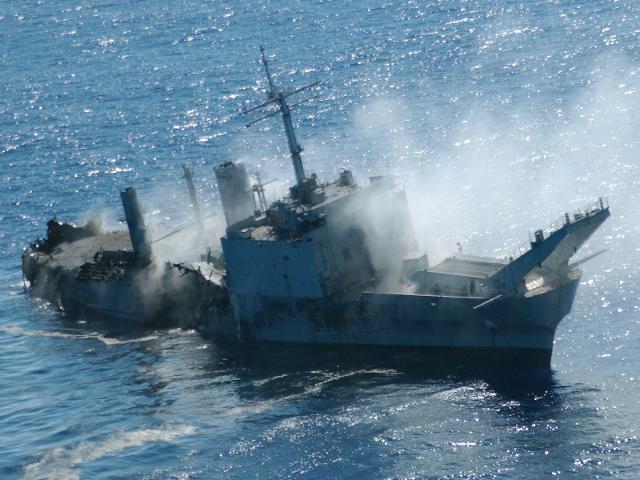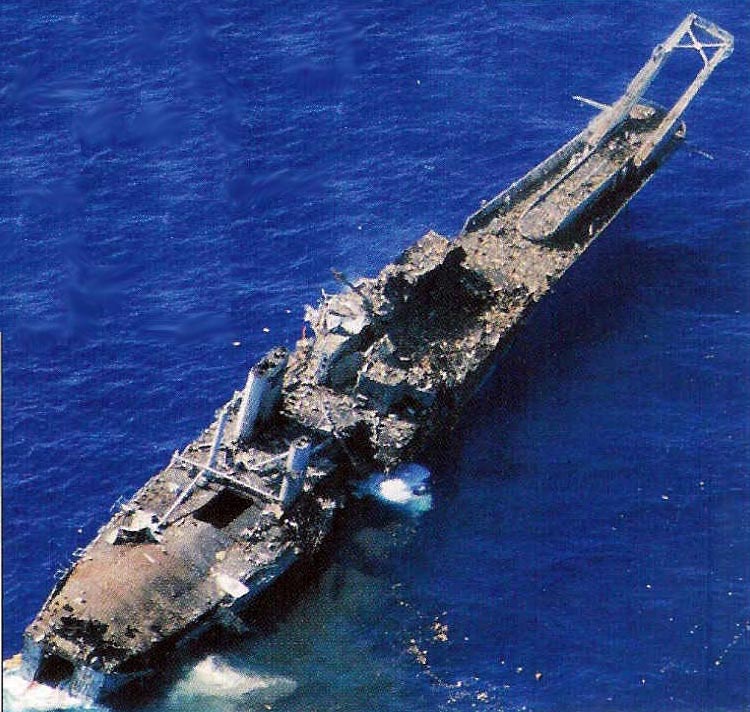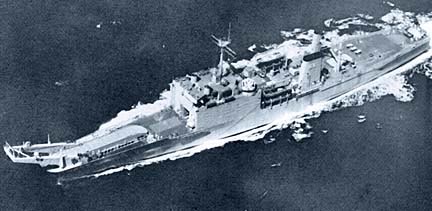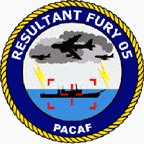Resultant Fury 05
The first-ever “Resultant Fury”
demonstration will take place in the vast expanse of the
Pacific Ocean Nov. 22-23, 2004. The two-phased
demonstration features B-52 and B-1 bombers meeting,
engaging and sinking multiple moving maritime targets.
This demonstration is aimed at showing that the US Air
Force has the capability to sink multiple moving ships in
all weather, day or night, be they used by enemy
combatants, terrorists, or those used for piracy. It will
mark the first time Air Force aircraft have used the JDAM
to sink a moving vessel.
Resultant Fury is a joint countersea demonstration,
initiated and directed by the Pacific Air Forces,
employing Air Force B-52s against moving maritime targets
in an all-weather environment, day or night. This
demonstration will take advantage of forward deployed
bombers in the Pacific and improve proficiency at both
the operational and tactical levels as well as provide
increased joint training proficiency. The maritime
exercise showcases the services' abilities to work
together to accomplish important warfighting missions.
Through real-time, all-weather technology, information
is fed [constant Intelligence, Surveillance and
Reconnaissance platforms to the Pacific Air Operations
Center enabling command and control elements near
real-time ability to track multiple moving sea targets
and feed that information to airborne pilots allowing
them to quickly engage and destroy the vessels.
Resultant Fury 05 marks the first time Navy and Air
Force aircraft, including B-52s out of Andersen AFB, Guam
and B-1s out of Dyess AFB, Texas, will engage multiple
moving maritime sea targets using J-Series weapons.
The two-day live-fire against maritime targets will
feature on day one two B-52s carrying Affordable Moving
Surface Target Engagement (AMSTE) modified GBU-31 (JDAM),
and two F/A-18s will carry two AMSTE-modified JSOW. These
B-52s and F/A-18s will engage multiple moving seaborne
targets. That same day, a B-1 will engage moving targets
utilizing its moving target tracking radar and general
purpose weapons. During day 2 of the demonstration three
B-52s will engage a landing ship tank (LST) with both
AMSTE modified JDAM and self-guided GBU-10s.
Two B-52s forward deployed to Andersen AFB, Guam will
be the central focus of this demonstration of maritime
interdiction. The inherent capabilities of the B-52-heavy
payload and long range-make it the perfect platform to
demonstrate countersea capabilities in this theater. B-52
Stratofortress bombers have always had the collateral
mission of countersea operations. The most common
countersea missions are sea surveillance, anti-ship
warfare, protection of sea lines of communications
through anti-submarine and anti-air warfare, and aerial
mining. Anti-ship warfare is commonly referred to as
maritime interdiction, or direct attack against maritime
targets.
One Air Force B-1, two Air Force E-8s, one Air Force
E-3, one Navy P-3, the Pacific Air Operations Center, two
F-18E/F fighters, three remote controlled ship targets,
three improved surface ship targets and 1 target will
also be involved in the Resultant Fury 05 demonstration.
More than 300 people will participate in the $10
million Resultant Fury 05 demonstration.
Resultant Fury 05-01 concluded in the Central Pacific
Nov. 23 with the targeting and destruction of a
decommissioned Navy tank landing ship, ex-USS
Schenectady. Personnel from both Navy and Air Force
services worked together to destroy multiple mobile
seaborne targets and attack ex-USS Schenectady, in a
unique training opportunity to sharpen at-sea warfighting
skills while using the latest in modern weaponry.
[http://www.globalsecurity.org/military/ops/resultant-fury.htm]
Resultant Fury 05-01 Concludes
Story Number: NNS041124-03
Release Date: 11/26/2004 9:00:00 AM
From U.S. Pacific Fleet Public Affairs
PEARL HARBOR, Hawaii (NNS) -- The two-day Navy and Air
Force anti-surface warfare exercise Resultant Fury 05-01
concluded in the Central Pacific Nov. 23 with the
targeting and destruction of a decommissioned Navy ship.
Personnel from both services worked together to destroy
multiple mobile seaborne targets and attack ex-USS
Schenectady, a decommissioned tank landing ship, in a
unique training opportunity to sharpen at-sea warfighting
skills while using the latest in modern weaponry.
Prior to the exercise, ex-USS Schenectady was stripped of
equipment and material and cleaned to remove hazardous
materials in preparation for being sunk.
“The Navy takes great care in preparing ships such
as the ex-Schenectady for targeting and sinking, removing
environmental contaminants and conducting the operations
greater than 50 nautical miles from shore and in at least
6,000 feet of water in accordance with EPA
guidelines,” said Cmdr. Dean Leech, fleet
environmental counsel. “Through these remediation
efforts as well as range procedures that prohibit the
exercise to occur if marine mammals are near the vessel,
we ensure protection of the environment while
accomplishing necessary testing and training.”
“It is essential that our forces train the way we
fight,” said Capt. Matt Brown, Pacific Fleet public
affairs officer. “The great benefit of this exercise
is that the Navy and the Air Force were able to practice
joint operational procedures using state-of-the-art joint
weapon systems, like Joint Stand Off Weapons and Joint
Direct Attack Munitions in the middle of the Pacific
Ocean.”
The exercise also served to integrate aircraft operations
with other Pacific Command and Air National Guard Forces,
allowing joint forces to continue to demonstrate the
ability to respond quickly to a crisis and project air
power anywhere in the Pacific region.
While the Navy routinely exercises anti-surface ship
operations, Air Force B-52s have historically shared this
mission area as well, and Resultant Fury proved the
perfect opportunity to train Navy and Air Force flight
crews together in the execution of a joint mission.
By working together to gain proficiency in this important
war-fighting skill set, the two services were able to
establish command and control procedures and evaluate
weapons effectiveness using two Air Force B-52s, two Air
Force E-8s, one Air Force E-3, two Navy F/A-18E/Fs and
one Navy P-3.
[http://www.news.navy.mil/search/display.asp?story_id=16069]
The sinking of the retired Navy LST USS Schenectady
off the coast of Hawaii on Tuesday night adds depth to
the missions and capabilities of the B-52 bomber. But for
the crew of the bomber that left Barksdale Air Force Base
about 10 hours earlier, it was a shake and a thrilling
video as the weapons slammed into the vessel.
"There's a slight shudder on the airplane when the
weight comes off," said Capt. Ronald Wheeler, San
Diego-reared radar-navigator of the 49th Test and
Evaluation Squadron that flew the 20.4-hour mission.
"You know when it leaves."
Maj. Terry Christiansen of Metairie, the aircraft
commander, said external munitions are propelled off
their external rails. "And since we ended up
releasing all four simultaneously, 8,000 pounds of weight
came off at the same time. So you feel it."
Their B-52 was one of two that took part in the last of
two days of Operation Resultant Fury, tests of a new
generation of smart bombs designed to find and sink
fast-moving ships. Planes taking part, mostly aircraft
that call Barksdale home -- even though many are deployed
temporarily to Andersen Air Force Base in Guam -- were
equipped with what the service calls its
"J-series" of smart weapons. But these were
enhanced with changes that allow a variety of different
aircraft to interact to find and sink rapidly maneuvering
surface vessels day or night.
"This was the first time ever a B-52 has gone out
and dropped self-designated, laser-guided weapons on a
moving ship," Christiansen said. "It's pretty
significant."
Though seven of the super-smart weapons were loaded on
the bomber late Monday, only the four externals were
fired.
Three in the bomb bay returned home with the aircraft.
The reason? A fishing vessel inadvertently entered the
range at Barking Sands Pacific Missile Range Facility
west of Hawaii. Due to the timing of the exercise, the
further release was called off by range safety officers.
"We were unable to contact the trawler or whatever
it was and had to cease that part of the exercise due to
the fishermen," Wheeler said.
"The last thing they wanted to do was have a safety
incident," Christiansen added.
Other than its effect on the balance of power, the
mission was pretty typical for a B-52: just more than 20
hours long with weapons dropped from about 6 nautical
miles up and a pretty fair distance from the target,
though just how high and how far out is classified.
There were two midair refuelings, one just off
California, the other off Hawaii, with the aircraft
slurping up about 245,000 pounds of jet fuel total.
For Wheeler, who actually toggled off the laser-guided
bombs and used what is called a Litening pod to guide
them in, the mission was "definitely exhilarating.
We took off from Barksdale, flew a 20-hour mission, got
to the target area on time and accomplished our
objective, which was to sink the ship.
"But to see the LST through the targeting pod I was
using to 'laze' the ship, to see it blow up in real time,
was pretty exciting. Any hostile surface vessel should
take heed."
In all, seven types of airplanes took part in the
exercise. Aside from B-52s, the aircraft were said to
include B-1 bombers, E-8C JSTARS and E3 Sentry command
and control aircraft, Navy F-18 Hornet and F-15E fighters
and KC-135 tankers.
"We're matching up advanced weapons with bomber
platforms in the Pacific," said Gen. David Deptula,
director of Pacific Air Forces Air and Space Operations.
"The ex-Schenectady sunk at 1:45 p.m. Hawaii
Standard Time," said Capt. David Faggard,
Hawaii-based spokesman for the operation's planning
agency, Pacific Air Forces.
"The bombing of the ship marks the first time ever
aircraft targeted and sunk multiple moving sea targets.
"Resultant Fury is a demonstration to allies and
adversaries in the Pacific that the U.S. Air Force has
the ability to rapidly respond and sink multiple moving
sea targets in any weather environment, day or
night," he said. "The United States is the only
nation with this capability."
None of the military people could or would name countries
whose moves might now be checked by the capability added
to the B-52 and other bombers.
But a civilian observer following the tests would.
One obvious recipient of the message could be China,
which has been expanding its maritime capabilities, said
Milton Finley, a military historian and chairman of the
Social Sciences Department at LSU Shreveport.
"But a message may have been sent to Iran and to
North Korea as well," he said.
"There has been a need for this capability because
Iran, for one, does have a large number of small patrol
boats in the Persian Gulf. This was a none-too-subtle
warning that if and when the French and Germans stop
groveling in front of the Iranians, it might be time for
payback."
[http://www.shreveporttimes.com/apps/pbcs.dll/article?AID=/20041125/NEWS01/411250365/1002/NEWS]
Air Force strikes
make 'Schenectady' history.
Some artifacts
retrieved before decommissioned ship sunk in military
exercise near Hawaii
By MIKE GOODWIN, Staff writer,
Times Union
First published: Wednesday, November 24, 2004
SCHENECTADY -- The USS Schenectady is no more.
The Air Force dropped satellite-guided bombs on the
long-mothballed 522-foot tank landing ship Tuesday afternoon
in a Pacific Ocean weapons test dubbed "Resultant
Fury," blowing massive holes in the city and county's
namesake vessel.
"We successfully struck the Schenectady," said
Capt. David Faggard, Pacific Air Forces spokesman at Hickam
Air Force Base in Hawaii. "It's definitely taking on
water. It's sinking."
The destruction of the ship occurred at about 5 p.m. EST.
A decade ago, Mayor Frank Duci mounted a failed effort to
move the decommissioned ship to Schenectady. But on Tuesday,
there was no saving the vessel, though a pod of whales
swimming in the vicinity of the ship forced a 40-minute
postponement of the attack.
B-52 bombers from Andersen Air Force Base in Guam pummeled
the ship with at least seven 2,000-pound satellite-guided
bombs developed by Northrop Grumman Corp., sending fireballs
and plumes of black smoke from the USS Schenectady, Faggard
said. B-52s from Barksdale Air Force Base in Shreveport, La.,
finished the job, striking the ship with laser-guided
missiles, though it could take some time for the ship to
sink.
"They all put holes in it, large, large holes,"
Faggard said.
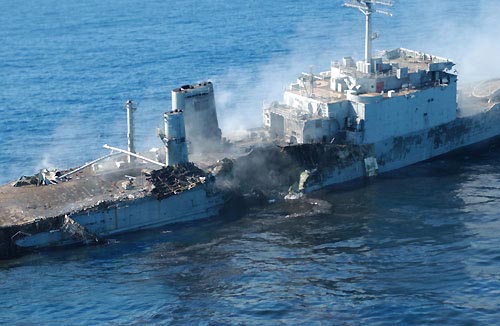
At
12:34 Hawaii Standard Time, B-52 bombers from
Andersen Air Force Base in Guam struck the
decommissioned USS Schenectady with seven
2,000 pound satellite-guided Joint Direct
Attack Munitions. A short time thereafter,
another B-52 struck the ship with four
laser-guided bombs. (Courtesy US Air Force)
The attack on the ship was the grand finale of a $10
million, two-day demonstration of Northrop Grumman's new
Joint Surveillance Target Attack Radar System.
The weapons system is the latest update of "smart
bombs" and will allow the military to hit moving targets
on land or at sea. Previously, such bombs could only be used
on stationary targets.
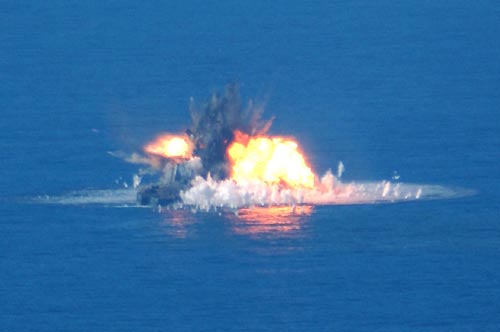
The
decommissioned USS Schenectady sunk at 1:45 p.m.
Hawaii Standard Time. The bombing of the ship
marks the first time ever aircraft targeted and
sunk multiple moving sea targets.
(Courtesy US Air Force)
The attack comes after the Navy secured a treasure trove
of artifacts from the ship, which was decommissioned in 1993.
Among the items the Navy historians held onto were the USS
Schenectady's wheel, bell and spy glass. Local military
retirees and historians hope to someday display the items in
Schenectady.
The ship was stripped of its insignias, plaques and other
distinguishing characteristics in preparation for the
exercise.
Kathryn Weller, curator of collections at the Schenectady
Historical Society on Washington Avenue, has been in contact
with Navy archivists who, she said, have assured her that a
number of items will be available for display in Schenectady.
"We can have the items for up to five years,"
she said.
Another exhibit of local USS Schenectady memorabilia is
currently on display at the historical society. Weller said
the organization is already planning an exhibit of the Navy
artifacts at the Gillette House, a Stockade landmark that is
undergoing renovations to house the county's chamber of
commerce.
"We would like to do a semi-permanent exhibit,"
Weller said.
The USS Schenectady is a Newport-class tank landing ship.
It was named after Schenectady County in 1970 at the
suggestion of a Schenectady elementary school pupil, who
wrote a letter to the secretary of the Navy.
At the time, Schenectady residents held a number of
functions to salute their namesake.
Chester "Chet" Watson of the Schenectady/Upper
Hudson Council of the Navy League said an exhibit will allow
local residents to celebrate the ship named in their honor.
"We're going to make a big deal about it," said
Watson, a retired Navy lieutenant commander.
[COURTESY U.S. NAVY]
The decommissioned USS Schenectady, which earned four battle
stars in Vietnam, will serve
as a bombing target for Air Force B-52 Stratofortress bombers
this month in Hawaiian waters.
Air Force B-52 Stratofortress bombers
from Guam will use "smart bombs" this month in
Hawaiian waters to sink a decommissioned troop transport,
as part of training to engage moving sea targets.
Capt. David Faggard, Pacific Air Forces
spokesman at Hickam Air Force Base, said the target will
be the 34-year-old Newport-class tank landing ship USS
Schenectady.
The Air Force demonstration, dubbed
"Resultant Fury," will take place in the
Pacific Missile Range Facility off Kauai's Barking Sands
beaches. About four F/A-18 fighter jets from Marine
Fighter Attack Squadron 22 will support the
demonstration, which be held between Nov. 16 and 24.
The 522-foot vessel will be towed Nov. 21
f rom the Navy's mothball fleet at Pearl Harbor, where
its been berthed since 1993, to an undisclosed location
near Kauai.
Faggard said B-52 crews from Guam will be
at the center of the demonstration of the Air Force's
maritime interdiction capabilities.
He said next week's mission is "to
demonstrate the bomber's ability to hit a moving target
with a JDAM (joint direct attack munition)," a
guided air-to-surface weapon.
Faggard added that "smart bombs" could be
used to take out a ship used by a terrorist without
harming nearby vessels or facilities. The bombs have been
used in the 1991 Gulf War and in the war in Iraq and
Afghanistan.
The Schenectady, which earned four battle stars for
service in Vietnam, is the fifth ship of the 20-ship
Newport tank landing ship class. It had a crew of 14
officers, 210 enlisted and could transport 350 troops.
Commissioned in June 13, 1970, the vessel was
homeported in San Diego until it was decommissioned on
Dec. 15, 1993.
It was then transferred to the Naval Inactive Ship
Maintenance Facility at Pearl Harbor and stricken from
the Navy rolls in 2001.
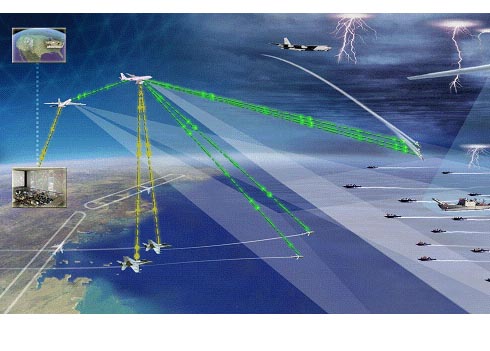 and the air-to-air refueling
tankers, the KC-135 from McConnell AFB, Kansas, Andersen
AFB, Guam, and Robbins AFB, Georgia. The B-2 Stealth
Bomber from Whiteman AFB, Mo will participate in the
demonstration with air refueling provided by a KC-10
tanker from Travis AFB, Calif.
and the air-to-air refueling
tankers, the KC-135 from McConnell AFB, Kansas, Andersen
AFB, Guam, and Robbins AFB, Georgia. The B-2 Stealth
Bomber from Whiteman AFB, Mo will participate in the
demonstration with air refueling provided by a KC-10
tanker from Travis AFB, Calif.